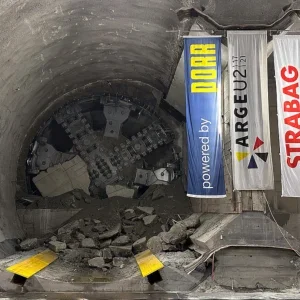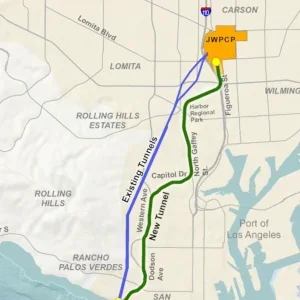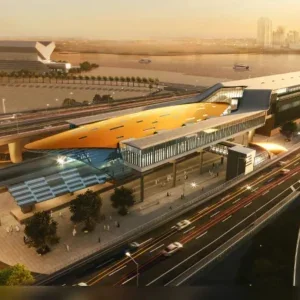The Seli TBM on New York’s East Side Access (ESA) project completed its first drive of a bifurcated tunnel last month and is being returned for relaunch to bore the lower branch.
Seli’s 6.7m diameter double shield – a refurbished Robbins original – was launched in late September 2007 with a preliminary configuration from a cavern below 63rd Street and 2nd Avenue. The final configuration was in place by early November.
A twin, bifurcated tunnel is being bored by a 6.7m variable diameter Robbins main beam TBM, which was launched less than three months after the first machine – shortly after the Seli machine had advanced over 200m and reached its final configuration. It will follow a similar sequence of excavation.
Both TBMs had to be brought from Queens on the other side of the East river through an immersed tube tunnel to their launch boxes.
Seli commented that while there was a common expectation of the second TBM being the faster to assemble, both machines took similar times. As such, the shorter delivery time for the refurbished machine has translated into it being launched about two months prior, and the machines have maintained steady progress.
Geology along the alignment comprises schist and gneiss of UCS 80MPa-200MPa. Lining is cast insitu concrete for the worst parts, and elsewhere ribs, mesh and bolts. More support has been needed than predicted for both first drives though cutter consumption in the abrasive schist is less (T&TNA, March, p12). In total, each machine is to drive approximately 3.85km in two runs.
The Italian firm, a subcontractor to the Dragados/Judlau joint venture, said average advance rates have been substantially the same when taking into account standby time for its machine when grouting, probing and draining.
Robbins said its main beam TBM has averaged 11.1m per day and reported that the Seli double shield averaged 9.8m per day. By early July, after the Seli shield had ended its first run, the Robbins’ main beam shield had driven 1.4km, or just over half, of its parallel 2.6km bore.
The grouting, probing and draining works have benefited both TBMs, added Seli. However, when deducted its shield performed 20% faster, it claimed.
In addition to difficult ground, the progress of the first drives is affected by being only 1.5m apart, which provides for only minimal tunnel support. The gripper and thrust pressure have been halved to stay within safe limits, said Robbins’ field service manager King Daniels.
Seli’s shield, built for disassembly and transport through the tunnel by having a ‘self-collapsing’ set-up of retractable shield cans, is being walked back along the tube to the chainage from were it is to be relaunched on the branch tunnel drive.
The Robbins shield’s variable diameter – enabled by unbolting four cutterhead sections, using hydraulically-positioned supports for its front, side and roof, and also collapsing the front shoe – will enable it to retreat for relaunch. The diameter can be reduced to 6.1m.
The project is being undertaken by Dragados/Judlau on a US$428M contract (CM009) with Capital Construction Co of the Metropolitan Transportation Authority (MTACC). The ESA project is part of the Long Island Rail Road (LIRR) scheme.
Late last year, as the machines were getting underway, the anticipated times for the turnarounds was about May for the Seli shield and mid-year for the Robbins TBM.
SELI’s ESA machine is making good progress The Robbins ESA machine Installing support behind the Robbins ESA machine







